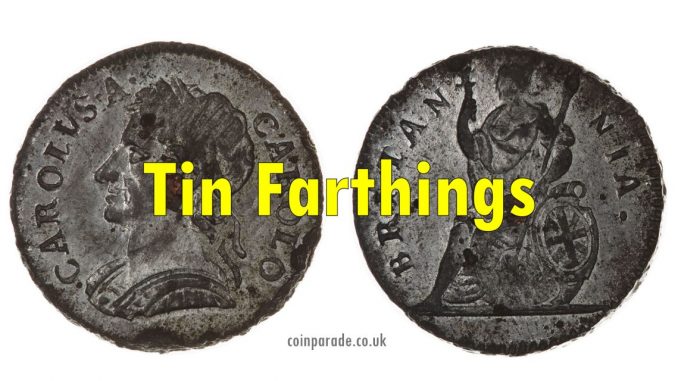
Charles II used tin as the metal for Farthings. Why tin? and why did they insert a copper plug?
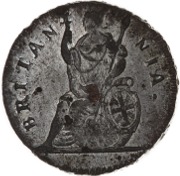 The 1684 Farthing - Charles II (Tin)
The 1684 Farthing - Charles II (Tin)Charles II Tin farthing with copper plug. The coin is dated on the edge. The reason this was made in tin rather than copper (which was used in previous years) was said to help the tin mining industry.
Making the coin in tin meant that the value of the metal was less than the face value of the coin itself. This situation often invites counterfeiters so a copper plug was created in the centre to make forgery more difficult.
The design was based on the earlier copper versions and it reminds me of a Roman coin. Top quality specimens are hard to find as tin does corrode. SCBC 3395 and there are various edge varieties. Made at the Tower Mint (Royal Mint) in London. Diameter 23mm and weighs 5.27g.
The Reverse shows Britannia sitting on a globe, facing left, holding a spear and olive branch. Her left hand rests on a shield showing a combination of the flags of St George and St Andrew. Legend is BRITANNIA.
The edge has the lettering NVMMORVM * FAMVLVS * 1684 * in raised letters. The meaning is 'servant of the coinage' suggesting the coin was a token and the metal value is less than the denomination.
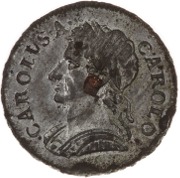 The Obverse shows a laureate bust of Charles II facing left and wearing armour. Legend is CAROLVS . A . CAROLO. meaning Charles after Charles, that is Charles II, and acknowledging his father Charles I.
The Obverse shows a laureate bust of Charles II facing left and wearing armour. Legend is CAROLVS . A . CAROLO. meaning Charles after Charles, that is Charles II, and acknowledging his father Charles I.Image credit: Museums Victoria.
Mintage: Not known
Minted at The Royal Mint
More information (monarch, year, mint, country, category) can be found below coin listings.
Below are some coins currently being offered on eBay. As an eBay Partner, We may be compensated if you make a purchase.
List items on:
List items on:
Charles II (1660-1685)
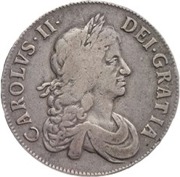 Charles II was King of England, Scotland, and Ireland. He was king of Scotland from 1649 until his deposition in 1651, and king of England, Scotland and Ireland from the 1660 Restoration of the monarchy until his death.
Charles II was King of England, Scotland, and Ireland. He was king of Scotland from 1649 until his deposition in 1651, and king of England, Scotland and Ireland from the 1660 Restoration of the monarchy until his death.The reign of Charles II is an interesting period for coin collectors. Charles issued many coins. When his father, King Charles I was executed, Charles II was forced into exile and Civil War raged in England. The first coins were those of Charles I, issued in the name of Charles II, minted around the country to pay armies. After the Reformation of the Monarchy, Charles II issued his own coins and from 1670 hammered coins were gradually replaced with milled coins.
The regnal years used on Charles II coins were:
1668:VICESIMO; 1669:VICESIMO PRIMO; 1670:VICESIMO SECVNDO; 1671:VICESIMO TERTIO; 1672:VICESIMO QVARTO; 1673:VICESIMO QVINTO; 1674:VICESIMO SEXTO; 1675:VICESIMO SEPTIMO; 1676:VICESIMO OCTAVO; 1677:VICESIMO NONO; 1678:TRICESIMO; 1679:TRICESIMO PRIMO; 1680:TRICESIMO SECVNDO; 1681:TRICESIMO TERTIO; 1682:TRICESIMO QVARTO; 1683:TRICESIMO QVINTO; 1684:TRICESIMO SEXTO.
Charles II coins usually use the latin spelling: Carolus II.
Category: Farthings
The Farthing was a small British coin that was worth one-quarter of an old penny - 1/960th of a Pound. It's name derives from the Anglo-Saxon feorthing or fourthling, meaning fourth part. It was last minted in 1956. Origins of the English Farthing
Farthings were minted as early as the 13th century under the reign of Edward I, although they may have been minted earlier under Henry III. Early examples are rare. These were small silver coins but they competed with 'cut-coinage' where a penny would be literally cut into four and used as a quarter of a penny. Farthing were minted in silver, copper and tin.
British Farthings
After the Act of the Union in 1707 (which unified England and Scotland), copper farthings were minted on a more regular basis. In 1799 Matthew Boulton started producing farthings in his steam-powered Birmingham factory (famous for making the cartwheel penny and twopence). The reverse was marked '1 FARTHING' which was the first time a denomination had ever appeared on a British or English coin. It was also the first coin to have the date on the same side as the Monarch. Boulton made another batch in 1806 and the Royal Mint took over in 1821. Farthing were made under George IV and William IV and the design was generally that of a small version of a penny, with Britannia on the reverse.
Farthings were minted in most of the years of Victoria's reign. The same obverse dies were used for the copper farthing and the sovereign and probably were used for the gold coin first. Victoria was the only monarch to have two obverses: a 'Bun' head and the Old or 'Veiled' head.
1860: Bronze replaces Copper
By 1860, the government decided to switch from copper to alloys so as to improve the quality of the coinage. Pennies, halfpennies and farthings were struck in bronze, both in Birmingham and at the Royal Mint. Bronze is 95% copper, 4% tin and 1% zinc and this was used with only minor changes until the end of the farthing in 1956.
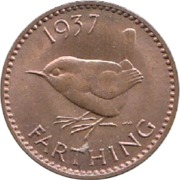 Farthings continued to be minted almost every year and the design was the same as the penny (with Britannia on the reverse). There was a pattern design for the Edward VIII farthing in 1936 but none were actually made in production.
Farthings continued to be minted almost every year and the design was the same as the penny (with Britannia on the reverse). There was a pattern design for the Edward VIII farthing in 1936 but none were actually made in production. The Wren and Demonetisation
In 1937 the farthing at long last got it's own unique reverse: a wren, designed by artist Harold Wilson Parker. By the 1950's inflation had eroded the spending power of the farthing (which was just 1/960th of a Pound) and with it the support of the public waned too. Production was discontinued after 1956 and the coin ceased to be legal tender after 31st December 1960.
Which Mint: The Royal Mint
The Royal Mint is the designated place for the UK to mint coins. It dates back well over 1000 years and is a Government-owned company. Formed in the reign of Alfred the Great about the year 886, during the period 1279-1812 it was generally referred to as The Tower Mint as it was housed at the Tower of London. The Master of The Royal Mint has included famous figures such as Sir Isaac Newton.
Since 2010 it has operated as Royal Mint Ltd, a company owned by HM Treasury, under an exclusive contract to supply all coinage for the UK although it also produces medals and coins for other countries. It is currently located at Llantrisant, Wales.
Country of Origin: United Kingdom
The United Kingdom (UK) is the Union of England, Scotland, Wales and Northern Ireland. It is often refered to as Great Britain (GBR). It has a long, rich history. The orignal coinage was Pounds, Shillings and Pence but since decimalisation on 15 February 1971, it is £1 = 100p, that is One Pound = 100 pence. The coinage of the UK is also a long history, the Royal Mint being established as long ago as 886AD when coins were hammered. Today there is perhaps 30 billion coins in circulation, and many (numismatic) collectors coins and sets are issued frequently in gold, silver and other metals.
List items on:
List items on:















